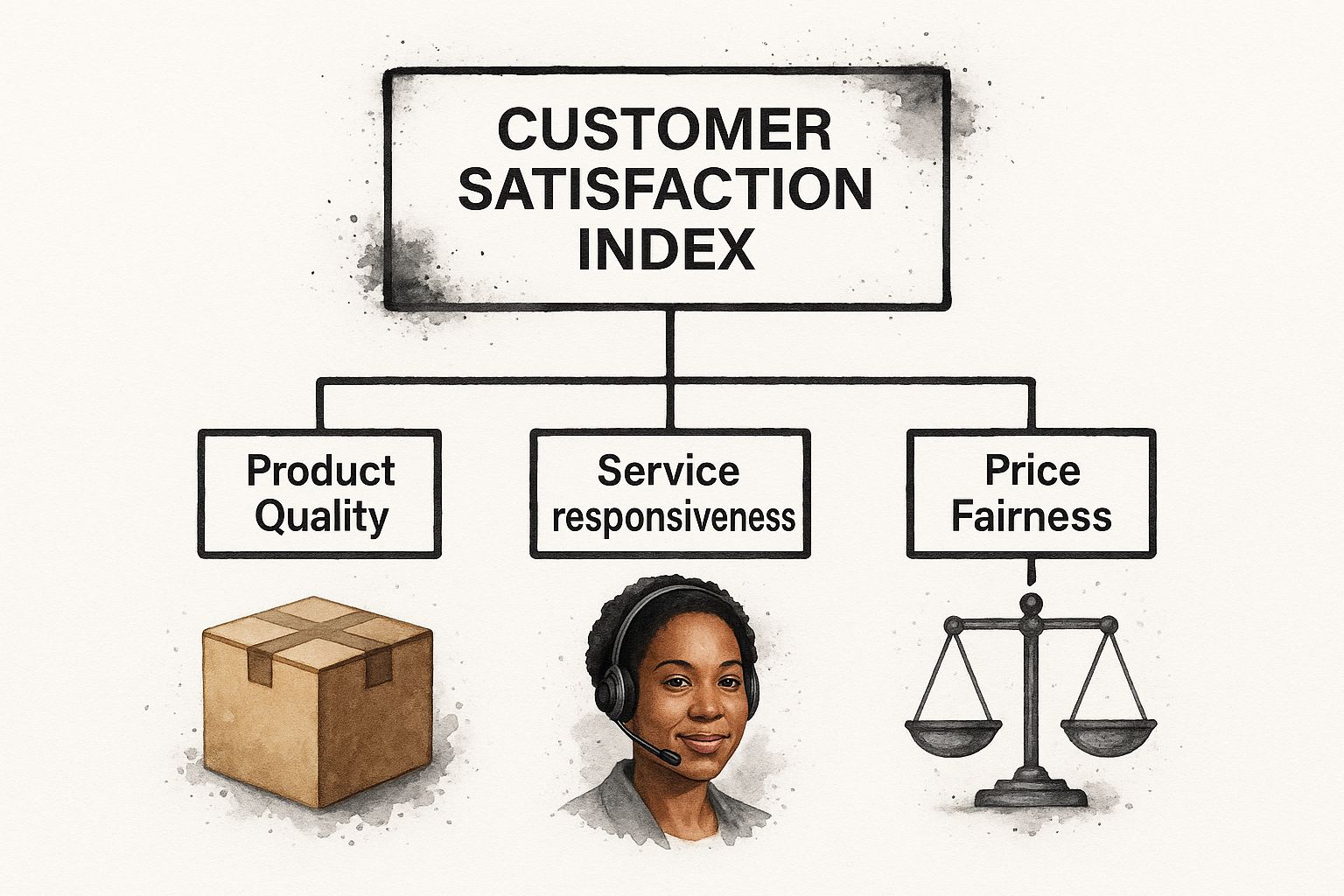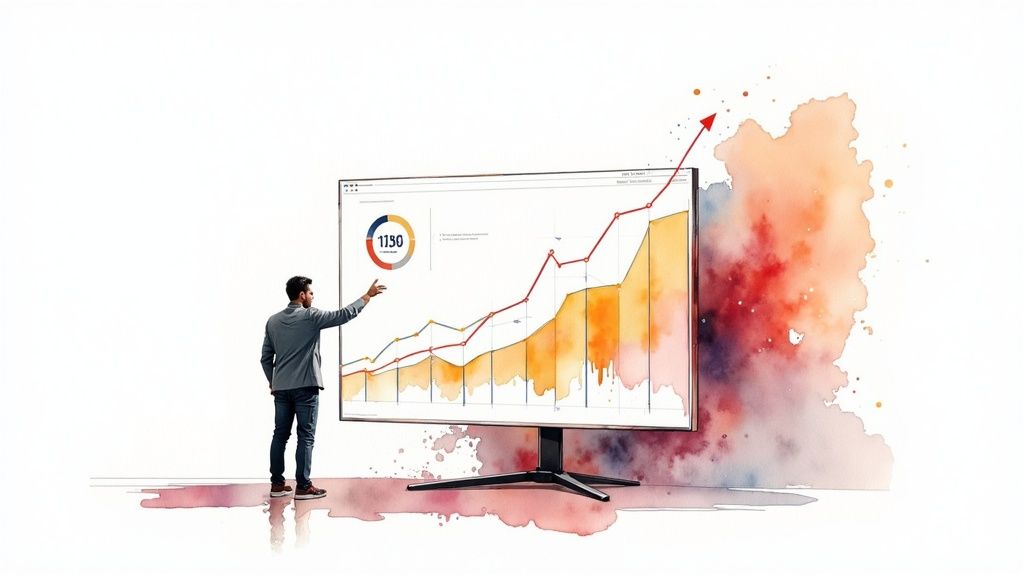Your Customer Satisfaction Score is a Useless Vanity Metric
Stop using a broken customer satisfaction index format. Here’s a founder's guide to building a system that measures what actually matters for survival.
Posted by
Related reading
Why Reputation Management Tools Matter More in 2025 Than Ever
Learn how reputation management tools help businesses track reviews, analyze feedback, and protect brand image. A modern guide with AI-driven insights using Backsy.
Sentiment Analysis Isn’t a “Nice-to-Have”. It’s a Lie Detector for Your Product.
Founders love chasing features, but customers speak in emotions. Learn what sentiment analysis really is, how it works, and how it reveals the truth behind your feedback. No fluff.
Reputation Management Tools: The Secret Weapon Behind Loyal Customers & Higher Revenue
Reputation management tools help you track customer opinions, detect red flags early, and convert negative feedback into retention wins. See how they work & why feedback-driven SaaS like Backsy outperforms survey-only tools.
Let's be blunt. That 9/10 satisfaction score you’re bragging about? It's a lie. It's a feel-good number that makes you think you're winning while your company is slowly bleeding out. You're high-fiving over a lagging indicator that says nothing about whether that "happy" customer will ever give you another dollar.
Ignore your customers, and you’ll be lucky to survive the quarter. But listen to the wrong metrics, and you’ll go broke with a smile on your face, wondering what went wrong.
You’re not in the business of making people temporarily happy. You’re in the business of building a customer base that funds your payroll.
Why Your 'Good' CSAT Score Is a Trap
We’ve all been sold the lie: a happy customer is a loyal customer. That’s a dangerous and expensive assumption. A high satisfaction score without loyalty is just a pat on the back on your way to bankruptcy court.
A customer can be "satisfied" with a transaction and have zero intention of ever thinking about you again. They got what they paid for, it was fine, and now they're gone. You didn’t win a fan; you completed a chore.
The Satisfaction vs. Loyalty Illusion
Here’s the hard truth: satisfaction and loyalty aren't the same thing.
Global studies prove this. Customer satisfaction hovers around a stable 76%, but loyalty metrics are a train wreck in comparison. That gap is where your churn comes from. If your index only measures satisfaction, you're measuring a feeling, not a future purchase. Feel free to explore the full research on this satisfaction-loyalty divergence, but the takeaway is simple.
Your traditional CSAT score is disconnected from the metrics that actually matter: churn and lifetime value.
Takeaway: Stop celebrating meaningless scores. It’s time to measure what keeps the lights on.
The Three-Pillar Index That Actually Works
Forget the textbook models. A customer satisfaction index format that isn't a complete waste of time boils down to three parts. Most founders only track the first one, which is like trying to drive by only looking in the rearview mirror.
If you aren't measuring these three things, you're not just guessing; you're making bad decisions with confidence.
The Only Metrics That Matter
Your index needs to measure the moment, the future, and the friction.
Pillar 1: Core Satisfaction (CSAT - The "Now") "How satisfied were you with this specific thing?" It's a snapshot. A quick pulse check. Globally, the average is around 76%. It’s simple, but it’s only one piece of the puzzle. You can learn more about global satisfaction benchmarks, but don’t get obsessed.
Pillar 2: Loyalty (NPS - The "Future") "How likely are you to recommend us?" This predicts future growth and churn. A customer might be satisfied today but won't stick around if they aren't loyal. They're a flight risk.
Pillar 3: Effort (CES - The "Friction") "How much work was this for you?" High effort is a silent killer. It drains goodwill and pushes people to competitors who aren’t a pain in the ass to deal with.
This image shows how these pillars connect to the bones of your business.

Satisfaction isn't abstract. It's tied to your product, your service, your price.
Ignoring any pillar is like trying to diagnose a patient by only checking their temperature. You're making critical decisions with junk data.
When you blend satisfaction, loyalty, and effort, you get a score that’s actually useful. It’s the difference between guessing where the fire is and having a thermal map to find it.
The No-BS Index Breakdown
I’ve seen too many founders get lost in vanity metrics. This table cuts through the noise.
| Metric Component | What It Actually Measures | Why You're Screwed Without It |
|---|---|---|
| Satisfaction (CSAT) | Happiness with one specific touchpoint. | You have no idea if your checkout process or support call is actively pissing people off. |
| Loyalty (NPS) | Future revenue and word-of-mouth. Your brand's long-term health. | You’re building a business on one-night stands, not long-term relationships. |
| Effort (CES) | The amount of friction in your customer journey. | You're bleeding customers not because your product sucks, but because using it is a chore. |
Takeaway: A real index isn't about pretty charts; it's a weapon for making smarter decisions.
How to Build This Thing Without a PhD

Enough theory. Let's talk about building a customer satisfaction index format that actually works. This isn't an academic exercise; it's a battle plan.
Stop overthinking the tools. Get started with SurveyMonkey or a damn Google Form. The magic isn't the software; it's the system.
Trigger your three core questions (CSAT, NPS, CES) at key moments: after closing a support ticket, finishing onboarding, or a repeat purchase. This isn't a once-a-year physical; it's a constant EKG on your business.
The Back-of-the-Napkin Formula
You don't need a data scientist. Start with this:
CSI = (CSAT Score * 0.4) + (NPS Score * 0.4) + ((10 - CES Score) * 0.2)
Why this weighting? CSAT (satisfaction) and NPS (loyalty) are your revenue engines. They get the most weight.
CES (effort) is the silent killer. The friction that grinds you down. We give it less weight, but we don't ignore it. Note we flip the CES score (10 - score) because high effort is bad. A higher number must always mean better.
Set up the data collection, plug it into a spreadsheet, and watch the number. Now you have a single metric that tells you if you're winning or losing the only game that matters.
Takeaway: A simple index you actually use is infinitely better than a "perfect" one you just talk about.
CSI Formats Designed to Fail
I’ve seen founders waste fortunes on surveys that are just corporate theater. They're designed to create pretty charts for a board meeting, not to stop customers from leaving. You might be using one right now.
The “Satisfaction-Only” Trap
This is the most common and dangerous format. It asks one question: "Were you satisfied?" It tells you nothing about whether that customer will stick around. Relying on this is chasing a vanity metric, not building a business.
The "Kitchen Sink" Questionnaire
This is born from fear. You’re afraid of not asking the one right question, so you ask 30. Who has time for that? Your response rates will tank, and the only data you’ll get is from the fanatics and the furious, skewing your results into oblivion.
Stop treating your customers like paid research subjects. Respect their time, or they'll stop giving it to you.
The “One-and-Done” Annual Report
Pure corporate performance art. You measure your index once a year, package it into a nice report, and everyone pats themselves on the back. It’s a complete waste of time. You get a single, static snapshot of one moment, missing the entire journey. You need a pulse, not a portrait.
Takeaway: If your survey is a one-trick pony, a novel, or a yearly ritual, you’re not gathering data. You’re collecting evidence for your company's autopsy.
Connect Your Index to Your Bank Account

Let's talk about what really matters: money. Any metric you track is a hobby unless it ties back to your P&L. Your customer satisfaction index format is worthless if you can't connect it to your bank account. It has to be a leading indicator for revenue.
We're not chasing "customer delight." We're trying to survive. You're looking for the tremors that warn you an earthquake is coming.
From Feel-Good Metric to Financial Tool
How do you link satisfaction to cash? Stop looking at your index as one big number. Slice it by the customer segments that actually pay your bills.
Segment by LTV: Are your highest-value customers—the ones who keep the lights on—your least satisfied? It's terrifyingly common. If your top 20% of clients have a CSI of 65 while your free-tier users are thrilled with a 90, you have a five-alarm fire.
Correlate with Churn: Plot your index scores next to your churn rate. See a pattern? If a dip in CSI this quarter leads to a spike in cancellations next quarter, congratulations. You just built a crystal ball. Now you can act before the revenue vanishes.
Ignoring this is expensive. U.S. companies lose $75 billion a year from bad service. Diving into the massive costs of customer dissatisfaction proves this isn't some optional exercise.
Your Customer Satisfaction Index isn’t a marketing metric. It’s a core financial health indicator, as critical as your cash flow statement.
Takeaway: If your CSI doesn't predict churn and LTV, it's just expensive corporate theater.
Stop Guessing. Start Knowing.
You can keep running your business on gut feelings, or you can build a system that tells you the hard truth. A proper customer satisfaction index format is an early warning system for churn and a compass for your roadmap.
The magic happens when you move beyond data collection and start analyzing customer feedback for the real story. A well-built index reveals the why behind the numbers. It forces you to confront the ugly parts of your business before they blow a hole in your MRR.
The choice is simple: build a real index or keep guessing. A great first step is learning how to get customer feedback that’s raw, not filtered.
Now, stop reading about it and do something.
Your Top CSI Questions, Answered Bluntly
Let's cut the crap. Here are the practical answers you need.
How Often Should I Measure This?
Measuring once a year is a rookie mistake. By the time you get the data, it's ancient history. You need a two-pronged attack:
- Transactional Checks: Survey them immediately after a key moment—a purchase, a support ticket resolution, onboarding completion. This is raw, in-the-moment feedback.
- Relational Pulse Checks: Track the overall index quarterly. This spots long-term trends and gauges the general health of your customer base.
One without the other leaves you flying blind.
What's a "Good" CSI Score?
This is a trick question. Anyone who gives you a single number is selling something. A good score is one that is consistently improving. Even better, it’s a score you can directly link to lower churn and higher LTV. It also helps to know how to calculate your customer satisfaction score so you know what the hell you're looking at.
Focus on beating your past self. Your 82 this quarter is more meaningful compared to your 78 last quarter than to some vague industry benchmark. You have no idea what went into their number.
Can I Just Use NPS Instead?
You could, but it would be like trying to run your company's finances by only looking at the cash in your wallet. NPS measures loyalty, but it's just one piece of the puzzle. It tells you if a customer will recommend you, but not why. It completely misses how they felt about their last purchase or how much of a pain it was to get help. Relying only on NPS creates massive, dangerous blind spots.
Stop chasing vanity scores and let Backsy build an early warning system for churn so you know what customers will do next, not just what they thought last week.